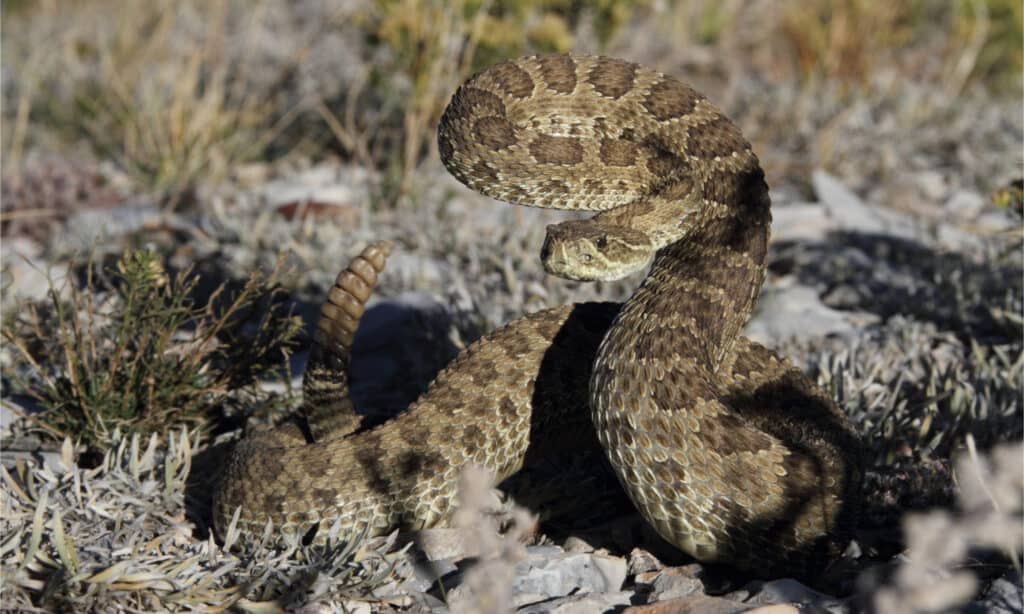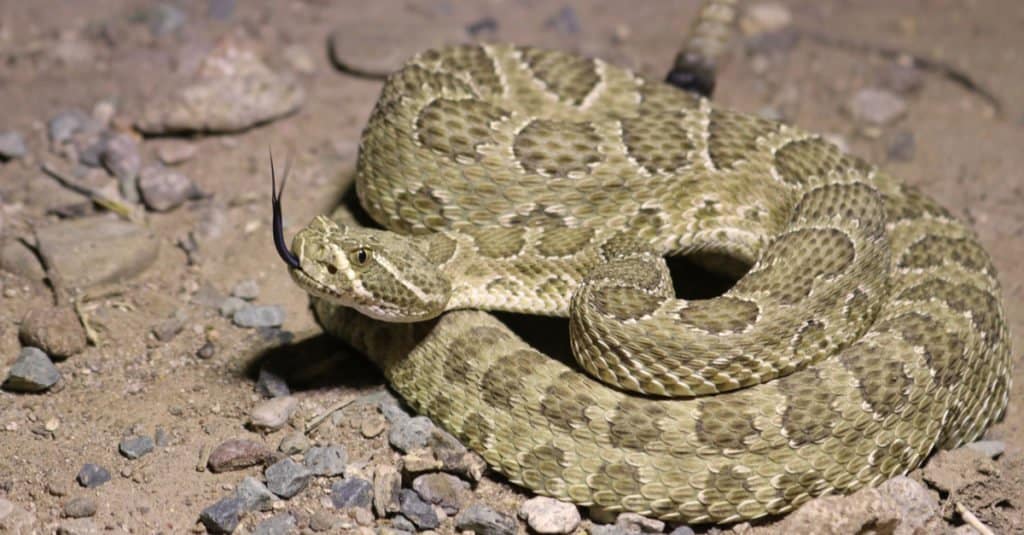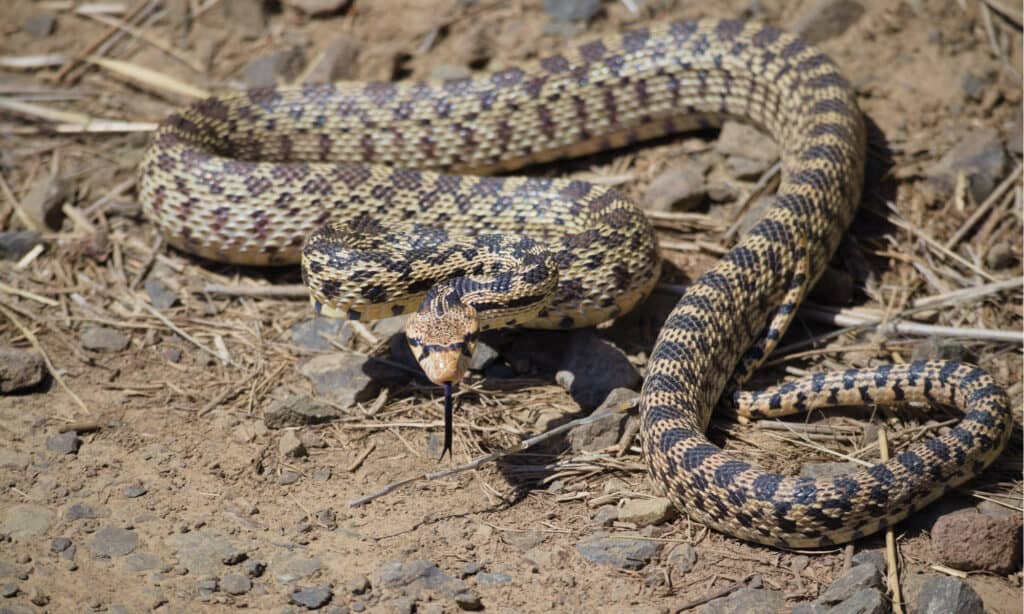Montana has many nicknames that describe the state’s natural beauty, like “Big Sky Country”, the “Treasure State”, and the “Land of the Shining Mountains”. Visitors from all over the world come to Montana to see its beautiful and rich natural environments, famous areas like Glacier National Park and Yellowstone National Park, and its diversity of wildlife. Although the state is also home to mountain lions and grizzly bears, people most commonly fear one animal in particular: snakes. However, often this fear is due to misunderstanding and superstitions. In fact, there are only 10 species of snakes that live in Montana, and only one that is venomous. Let’s take a look at Montana’s only rattlesnake species.
Prairie Rattlesnake (or Western Rattlesnake)

Prairie rattlesnakes prefer the dry and rocky areas of Montana, but also live in areas with some vegetation.
©Nina B/Shutterstock.com
| Prairie Rattlesnake | |
|---|---|
| Range | All of Montana except for Northwestern Corner |
| Length | 15-60 inches |
The Prairie Rattlesnake (also known as the Western Rattlesnake) lives all throughout Montana, except for in the northwestern corner of the state. Glacier National Park, for instance, does not have any rattlesnakes, although there are many grizzly bears you should watch out for. Prairie rattlesnakes typically prefer dry, rocky habitats, but they also live in areas with tall grass, ponderosa pine, mixed grass-coniferous forests, and along riverbanks. These snakes often are seen basking in the sun on southern-facing rocky slopes. Like many snake species, prairie rattlesnakes share a communal den with several other rattlesnakes. However, these snakes often travel several miles beyond their den in search of food.
Appearance

Although prairie rattlesnakes primarily live on the ground, they do occasionally climb trees, shrubs, and boulders.
©DMartin09/Shutterstock.com
Prairie rattlesnakes have thin necks with large, triangular-shaped heads. Behind each of the snake’s eyes is a dark stripe bordered on both sides by a white stripe. These snakes are Pit Vipers, with heat-sensing “pit” organs on their faces that look like a second set of nostrils. Prairie rattlesnakes have hollow fangs that they use to inject venom into their prey. These fangs are also hinged, so that the snake can fold them back against the roof of its mouth. These snakes have heavy bodies that can be anywhere from 15-60 inches in length. However, rattlesnakes in Montana tend to be the biggest in the United States. Many prairie rattlesnakes regularly grow to four feet in length.
These snakes have keeled scales along their bodies, which means that each scale has a texturized ridge in the middle of it. These keeled scales give the snake a rough, bristly appearance. Although there are many different colors and shades of prairie rattlesnakes, they usually have a base color of tan, brown, pale green or olive green. Black or brown blotches run along the center of their backs with both dark and light outlines. They also have smaller blotches along the sides of their bodies, and plain white or pale-yellow bellies.
At the end of snake’s tail, the dark blotches morph into rings, and of course end with a keratin rattle. You can easily identify a rattlesnake because this characteristic boney-like rattle. However, rattlesnakes can lose and regrow their rattles. Young prairie rattlesnakes have toxic venom as soon as they are born and look very similar to adult rattlesnakes. However, they typically have brighter colors.
Behavior

When the weather is cooler, prairie rattlesnakes are active during the day. When it’s hot, however, prairie rattlesnakes tend to come out more at night.
©Harris Motion Photo/Shutterstock.com
Prairie rattlesnakes are ambush predators and can patiently wait for long periods of time. These snakes typically choose a hiding spot to wait for prey that is slightly raised, such as a tree stump, log, or rock. They prefer to stay on the ground, but on occasion they will climb trees. The prairie rattlesnake waits in its hiding spot until its prey passes by, then strikes and inject its toxic venom. Prairie rattlesnakes primarily eat mammals like mice, rats, rabbits, ground squirrels, and prairie dogs. However, on occasion they will also eat reptiles, other snakes, amphibians, and sometimes even ground-nesting birds. Younger snakes focus on smaller prey like lizards.
Rattlesnakes are venomous, so you should always be cautious anytime you are in areas where they might live. However, prairie rattlesnakes, although common throughout Montana, are shy and prefer to avoid humans and other large animals. If a rattlesnake feels threatened, it will coil its body and raise its head and neck to appear larger. The snake will also rattle its tail loudly as a warning. Prairie rattlesnakes only bite as a last resort, but it is always best to keep your distance. The venom of a prairie rattlesnake has a complex mix of various proteins, including both hemotoxic and neurotoxic properties.
What to Do if You Encounter a Prairie Rattlesnake

Prairie rattlesnakes are common around Billings, Montana’s largest city.
©Creeping Things/Shutterstock.com
The odds of being bitten by a prairie rattlesnake are extremely small, particularly if you do your best to leave these snakes alone. Most bites happen when a rattlesnake is accidentally stepped, or if it is harassed. When visiting areas where rattlesnakes live, wear protective boots, and keep a close eye on any pets and children with you.
However, if you are bitten by a rattlesnake, it is important to get medical assistance as quickly as possible. However, remember to stay calm and keep your movements as limited as possible. If you are far from transportation, for example, do not run. Walk calmly and do your best to keep your heart rate down, or if you can, call an ambulance. Remove any constricting jewelry (rings, bracelets, watches, etc.), as the bite and surrounding flesh will swell. Never try to kill the snake or take it with you; even a dead rattlesnake still has venom and can still bite. Instead, call ahead to the hospital so they can have antivenom ready for when you arrive.
Other Snakes in Montana
In addition to prairie rattlesnakes, Montana is home to a few other snake species that look like rattlesnakes. Unlike rattlesnakes, however, these snakes are not dangerous at all. If you come across a snake and you are not sure what species it is, stay at least six feet away and leave the snake alone Unfortunately, many people kill or injure these harmless snakes out of fear, due to their appearance. Let’s look at some of the harmless rattlesnake “look-a-likes” in Montana.
Gophersnake (or Bullsnake)

When threatened, the Bullsnake rears up in an S-shape, hisses and vibrates its tail to mimic the venomous rattlesnake.
©Christopher Joe Brown/Shutterstock.com
| Bullsnake | |
|---|---|
| Range | All of Montana |
| Length | 36-84 inches |
The bullsnake (a subspecies of the gophersnake) may look intimidating with its large, muscular body, but this nonvenomous snake is not aggressive. In fact, it is harmless to humans. These snakes are the largest snake in Montana and are typically 3-5 feet long. However, they can grow up to 7 feet in length! Bullsnakes can be found throughout most of Montana, although they are not as common in the northwest and southwest corners of the state. These snakes have rough-looking scales and colors like prairie rattlesnakes. However, bullsnakes do not have a rattle at the end of their tails. In addition, these snakes have smaller, bullet-shaped heads rather than broad triangular heads like rattlesnakes. Bullsnakes are typically a yellowish-tan color with uniform dark brown or red blotches running along the length of their bodies. They also have smaller blotches along both sides of their bodies, and their scales are keeled.
Plains Hognose Snake (Western Hognose Snake)

The plains hognose snake has a wide head and an upturned snout.
©Amanda Guercio/Shutterstock.com
| Plains Hognose Snake | |
|---|---|
| Range | Eastern 2/3 of Montana |
| Length | 15-25 inches |
The plains hognose Snake (also known as the western hognose snake) has a very thick and heavy body with keeled scales. However, these snakes are much smaller, usually between 15-25 inches long. The plains hognose snake lives in the eastern 2/3 of Montana. These snakes get their name from their unique up-turned, short snouts that they use to burrow through dirt and loose soil. Plains hognose snakes are tan or light brown, with dark blotches along their back and sides. These snakes have a very mild venom that they use to hunt small mammals, amphibians, and insects. However, they are harmless to humans. In fact, captive-bred hognose snakes are becoming increasingly popular pets. A bite from a plains hognose snake may cause slight swelling. However, these snakes rarely bite.
The photo featured at the top of this post is © Tom Reichner/Shutterstock.com
Discover the "Monster" Snake 5X Bigger than an Anaconda
Every day A-Z Animals sends out some of the most incredible facts in the world from our free newsletter. Want to discover the 10 most beautiful snakes in the world, a "snake island" where you're never more than 3 feet from danger, or a "monster" snake 5X larger than an anaconda? Then sign up right now and you'll start receiving our daily newsletter absolutely free.
Thank you for reading! Have some feedback for us? Contact the AZ Animals editorial team.






